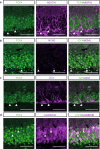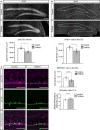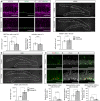Enriched environment ameliorates adult hippocampal neurogenesis deficits in Tcf4 haploinsufficient mice
- PMID: 33228529
- PMCID: PMC7684915
- DOI: 10.1186/s12868-020-00602-3
Enriched environment ameliorates adult hippocampal neurogenesis deficits in Tcf4 haploinsufficient mice
Abstract
Background: Transcription factor 4 (TCF4) has been linked to human neurodevelopmental disorders such as intellectual disability, Pitt-Hopkins Syndrome (PTHS), autism, and schizophrenia. Recent work demonstrated that TCF4 participates in the control of a wide range of neurodevelopmental processes in mammalian nervous system development including neural precursor proliferation, timing of differentiation, migration, dendritogenesis and synapse formation. TCF4 is highly expressed in the adult hippocampal dentate gyrus - one of the few brain regions where neural stem / progenitor cells generate new functional neurons throughout life.
Results: We here investigated whether TCF4 haploinsufficiency, which in humans causes non-syndromic forms of intellectual disability and PTHS, affects adult hippocampal neurogenesis, a process that is essential for hippocampal plasticity in rodents and potentially in humans. Young adult Tcf4 heterozygote knockout mice showed a major reduction in the level of adult hippocampal neurogenesis, which was at least in part caused by lower stem/progenitor cell numbers and impaired maturation and survival of adult-generated neurons. Interestingly, housing in an enriched environment was sufficient to enhance maturation and survival of new neurons and to substantially augment neurogenesis levels in Tcf4 heterozygote knockout mice.
Conclusion: The present findings indicate that haploinsufficiency for the intellectual disability- and PTHS-linked transcription factor TCF4 not only affects embryonic neurodevelopment but impedes neurogenesis in the hippocampus of adult mice. These findings suggest that TCF4 haploinsufficiency may have a negative impact on hippocampal function throughout adulthood by impeding hippocampal neurogenesis.
Keywords: Adult neurogenesis; Enriched environment; Hippocampus; Intellectual disability; PTHS; Tcf4.
Conflict of interest statement
The authors declare that they have no competing interests.
Figures




Similar articles
-
Analysis of the expression pattern of the schizophrenia-risk and intellectual disability gene TCF4 in the developing and adult brain suggests a role in development and plasticity of cortical and hippocampal neurons.Mol Autism. 2018 Mar 22;9:20. doi: 10.1186/s13229-018-0200-1. eCollection 2018. Mol Autism. 2018. PMID: 29588831 Free PMC article.
-
Common Pathophysiology in Multiple Mouse Models of Pitt-Hopkins Syndrome.J Neurosci. 2018 Jan 24;38(4):918-936. doi: 10.1523/JNEUROSCI.1305-17.2017. Epub 2017 Dec 8. J Neurosci. 2018. PMID: 29222403 Free PMC article.
-
Tcf4 dysfunction alters dorsal and ventral cortical neurogenesis in Pitt-Hopkins syndrome mouse model showing sexual dimorphism.Biochim Biophys Acta Mol Basis Dis. 2024 Jun;1870(5):167178. doi: 10.1016/j.bbadis.2024.167178. Epub 2024 Apr 16. Biochim Biophys Acta Mol Basis Dis. 2024. PMID: 38636614
-
An attempt to explain what intrinsically disordered TCF4 does in its spare time when PTHS-related mutations prevent it from doing its job.Cell Commun Signal. 2025 Jun 1;23(1):258. doi: 10.1186/s12964-025-02265-1. Cell Commun Signal. 2025. PMID: 40452023 Free PMC article. Review.
-
Molecular and Cellular Function of Transcription Factor 4 in Pitt-Hopkins Syndrome.Dev Neurosci. 2021;43(3-4):159-167. doi: 10.1159/000516666. Epub 2021 Jun 16. Dev Neurosci. 2021. PMID: 34134113 Free PMC article. Review.
Cited by
-
Psychiatric risk gene Transcription Factor 4 (TCF4) regulates the density and connectivity of distinct inhibitory interneuron subtypes.Mol Psychiatry. 2023 Nov;28(11):4679-4692. doi: 10.1038/s41380-023-02248-z. Epub 2023 Sep 28. Mol Psychiatry. 2023. PMID: 37770578 Free PMC article.
-
Multisensory gamma stimulation enhances adult neurogenesis and improves cognitive function in male mice with Down Syndrome.PLoS One. 2025 Apr 24;20(4):e0317428. doi: 10.1371/journal.pone.0317428. eCollection 2025. PLoS One. 2025. PMID: 40273201 Free PMC article. No abstract available.
-
Music with Different Tones Affects the Development of Brain Nerves in Mice in Early Life through BDNF and Its Downstream Pathways.Int J Mol Sci. 2023 May 1;24(9):8119. doi: 10.3390/ijms24098119. Int J Mol Sci. 2023. PMID: 37175826 Free PMC article.
-
Enriched Environment Induces Sex-Specific Changes in the Adult Neurogenesis, Cytokine and miRNA Expression in Rat Hippocampus.Biomedicines. 2023 May 2;11(5):1341. doi: 10.3390/biomedicines11051341. Biomedicines. 2023. PMID: 37239012 Free PMC article.
-
Dual recombinase-mediated intersectional genetics defines the functional heterogeneity of neural stem cells in adult hippocampus.Mol Psychiatry. 2025 Aug;30(8):3516-3532. doi: 10.1038/s41380-025-02937-x. Epub 2025 Feb 24. Mol Psychiatry. 2025. PMID: 39994425
References
-
- Mary L, Piton A, Schaefer E, Mattioli F, Nourisson E, Feger C, et al. Disease-causing variants in TCF4 are a frequent cause of intellectual disability: lessons from large-scale sequencing approaches in diagnosis. Eur J Hum Genet. 2018;26(7):996–1006. doi: 10.1038/s41431-018-0096-4. - DOI - PMC - PubMed
-
- Bedeschi MF, Marangi G, Calvello MR, Ricciardi S, Leone FPC, Baccarin M, et al. Impairment of different protein domains causes variable clinical presentation within Pitt-Hopkins syndrome and suggests intragenic molecular syndromology of TCF4. Eur J Med Genet. 2017;60(11):565–571. doi: 10.1016/j.ejmg.2017.08.004. - DOI - PubMed
Publication types
MeSH terms
Substances
Supplementary concepts
Grants and funding
LinkOut - more resources
Full Text Sources
Other Literature Sources

